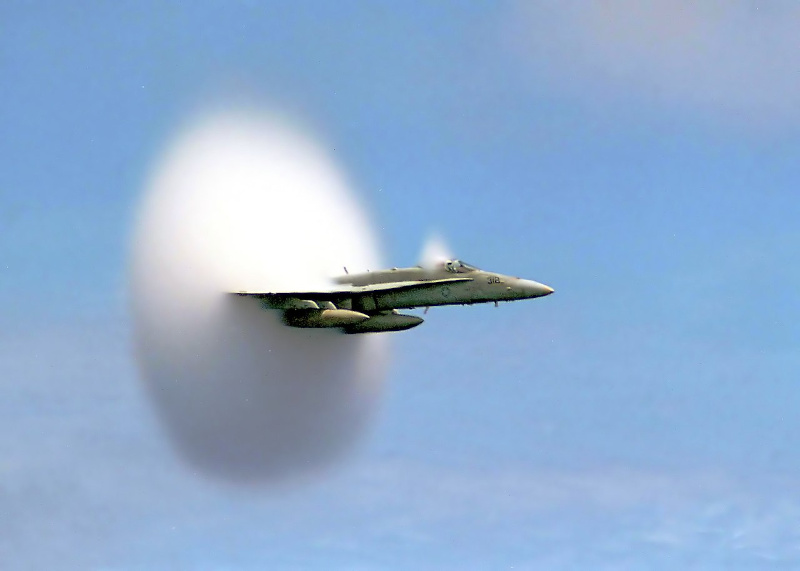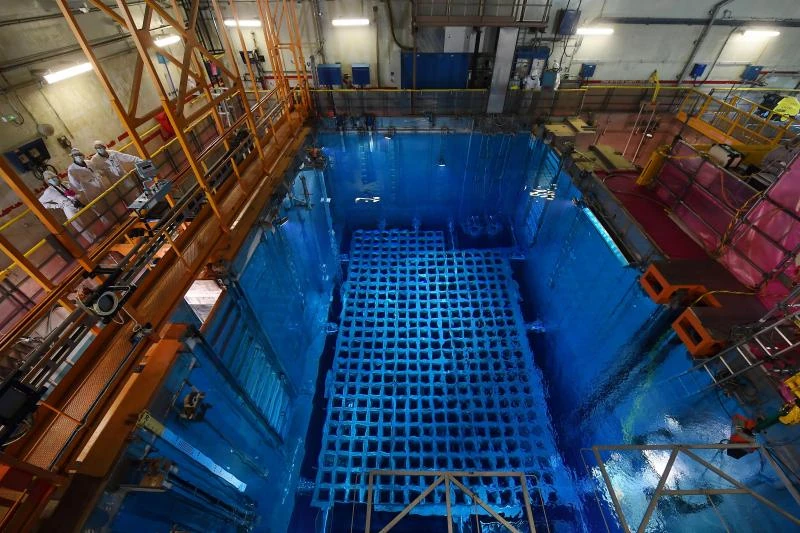
Image description: The Mach cone is a relevant image of the concept of shock waves and sound barriers. When an aircraft exceeds Mach 1, the waves arrange themselves into a cone with the aircraft at the tip. The boundary between the Mach cone and the outside forms a hyperbola that advances with the aircraft. The intensity of the bang is the result of the sudden change in pressure when the air pressure abruptly returns to its natural average equilibrium. This implosion of the wave upon itself causes the bang. Credit: FA-18 Hornet breaking the sound barrier on July 7, 1999 by Ensign John Gay, U.S. Navy
Before explaining the Cherenkov effect, it's important to understand the phenomenon that creates the shock wave produced behind an aircraft exceeding the speed of sound (≈340 m/s).
When the aircraft's speed is less than the speed of sound, sound waves propagate around it in all directions. These concentric spheres of air pressure increase their radius by 340 meters each second, and the aircraft is always within the wave front. Thus, the sound waves produced by the collisions of air molecules move faster than the aircraft and their energy dissipates slowly with the square of the distance (i=p/4πr2).
However, as the aircraft's speed increases, the waves in front of it get closer together and compress more, while those behind stretch out. This effect of dilation and contraction of sound frequencies causes the Doppler effect (the sound of approaching objects seems higher pitched!).
The intensity of sound waves can add up like the heights of waves can combine when they meet. As long as the aircraft is moving slower than the sound waves it creates, the waves remain confined within each other without their energy adding up.
But when the aircraft reaches the speed of sound, while generating new waves from its current position, waves that are in the same phase gather and accumulate in front of it, and pressure suddenly rises, forming a shock wave. Then the pressure decreases along the aircraft only to rise again suddenly at the tail of the aircraft. These two overpressures cause two supersonic bangs so close together that our ear perceives them as one. This bang is not heard by passengers because the pressure shock behind the aircraft cannot catch up with it. The shock waves then propagate in a cone known as the Mach cone.
At the moment the aircraft exceeds Mach 1, it instantly breaks through the compressed air barrier that had formed in front of it, which is known as the sound barrier. The produced shock wave causes abrupt variations in pressure and temperature in the surrounding air. Sometimes the air temperature drops below the dew point, causing the water vapor in the air to condense into fine droplets forming a cloud that accompanies the aircraft in its supersonic flight as shown in the attached photo.

Image description: The bluish luminosity of the cooling water in nuclear power plants' spent fuel pools is generated by the Cherenkov effect. The speed of light in a vacuum (299,792 km/s) is the maximum speed of energy movement. But the speed of light in water (225,563 km/s) can be exceeded, which makes the Cherenkov effect possible. Credit: Cherenkov Radiation in the core of the Advanced Test Reactor, Idaho National Laboratory.
Cherenkov light, named after Russian physicist Pavel Cherenkov (1904-1990), is a flash of light produced by a charged particle when it moves through a material medium (such as water or air) at a speed greater than the speed of light in that medium. The speed of light in a vacuum remains always greater than this.
The analogy between the Cherenkov effect and the supersonic shock wave is easy to imagine.
An aircraft traveling faster than sound in the air creates a shock wave on which all sound waves converge. The correspondence with the Cherenkov effect is made by replacing the aircraft with a charged particle and the sound with light.
In a material medium like water or air, light travels at a speed of c1 = c/n.
c = speed of light in a vacuum
n = refractive index of the medium, always > 1 (examples: air=1.0003, water=1.333, optical fiber=1.5, diamond=2.41)
A charged particle can move through this medium at a speed v greater than c1 but still less than c, which does not contradict the theory of relativity.
What explains this blue radiative emission in water?
The charged particle interacts throughout its trajectory with the medium it traverses. During its journey through water, it temporarily disturbs the atoms it encounters. In other words, the electrons deviate from their initial position and then return to their place. Thus, each atom encountered by the particle releases the absorbed energy and becomes an emitter of radiation. All the waves emitted by each of the atoms overlap disorderly, they have different phases, so their sum cancels out.
However, the speed of the charged particle in water, which can be likened to the supersonic aircraft, is faster than the speed of the wave emitted by each atom in the water. When the particle exceeds the speed of light in the medium, all the waves align in the same phase and thus add up constructively, just like in the case of the supersonic shock wave. This phenomenon creates a wave front analogous to the sound barrier in the Mach cone. A sudden transition occurs along the entire trajectory of the particle, about 10 billion times per meter. The Cherenkov effect manifests itself throughout the path by the emission of a light wave at all wavelengths, with a predominance in blue and ultraviolet.
These flashes explain the blue light of the cooling pools of spent nuclear fuel. It is due to energetic electrons emitted by radioactivity reaching speeds higher than the speed of light in water.
Cherenkov detectors are located in large water tanks and are used for detecting very high-energy particles (Antarctic Muon and Neutrino Detector Array, Super-Kamiokande).
Cherenkov light is also involved in the detection of neutrinos produced in nuclear reactions at the core of the Sun (Sudbury Neutrino Observatory).
Apollo mission astronauts all complained about seeing phosphene flashes during their missions. It was discovered that these visual disturbances were due to the Cherenkov effect. Solar wind particles passing through the liquid of the eye globes produce phosphene flashes. Such phosphene flashes also occur on Earth, at an average rate of one or two per person per year.